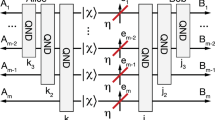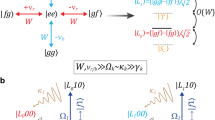Abstract
Improving the signal-to-noise ratio in optical communication systems is a fundamental requirement for cost-effective data transmission. This is particularly important for the transmission of noise-intolerant quantum states: excess noise at the quantum level destroys the coherence of the states, rendering classical error correction or amplifier-based schemes1 useless for quantum communication. Only quantum error correction2,3 can remove the effects of noise without corrupting the fragile superpositions of quantum states. But difficulties arise in the practical implementation of such a correction process because nonlinear operations4 have been thought to be required, greatly reducing the efficiency of any optical scheme. Here I report an efficient, compact scheme involving only linear optical elements and feedback, which performs error correction for both quantum and classical noise. In the classical case, the noise penalty incurred is no worse than for ideal amplification. But for low-noise quantum optical communication, this penalty may be eliminated entirely. This quantum error-correction scheme may thus find application in quantum cryptographic networks5,6,7 (where low noise is equivalent to high security), possibly extending their range far beyond limits imposed by system losses7.
This is a preview of subscription content, access via your institution
Access options
Subscribe to this journal
Receive 51 print issues and online access
$199.00 per year
only $3.90 per issue
Buy this article
- Purchase on Springer Link
- Instant access to full article PDF
Prices may be subject to local taxes which are calculated during checkout
Similar content being viewed by others
References
Haus, H. A. & Mullen, J. A. Quantum noise in linear amplifiers. Phys. Rev. 128, 2407–2413 (1962).
Shor, P. W. Scheme for reducing decoherence in quantum computer memory. Phys. Rev. A 52, R2493–R2496 (1995).
Steane, A. M. Error correcting codes in quantum theory. Phys. Rev. Lett. 77, 793–797 (1996).
DiVincenzo, D. P. & Smolin, J. in Proc. Workshop on Physics and Computation PhysComp '94 14–23 (IEEE Computer Soc. Press, Los Alamitos, CA, 1994).
Bennett, C. H. & Brassard, G. The dawn of a new era for quantum cryptography: the experimental prototype is working! SIGACT News 20, 78–82 (1989).
Townsend, P. D., Rarity, J. G. & Tapster, P. R. Enhanced single photon fringe visibility in a 10 km-long prototype quantum cryptography channel. Electron. Lett. 29, 1291–1293 (1993).
Muller, A. et al. Plug and play systems for quantum cryptography. Appl. Phys. Lett. 70, 793–795 (1997).
Shor, P. W. in Proc. 35th Annual Symp. on the Foundations of Computer Science (ed. Goldwasser, S.) 124–134 (IEEE Computer Soc. Press, Los Alamitos, CA, 1994).
Wootters, W. K. & Zurek, W. H. Asingle quantum cannot be cloned. Nature 299, 802–803 1982).
Braunstein, S. L. Error correction for continuous quantum variables. Phys. Rev. Lett. 80, 4084–4087 (1998).
Lloyd, S. & Slotine, J.-J. E. Analog quantum error correction. Phys. Rev. Lett. 80, 4088–4091 (1998).
Reck, M. et al. Experimental realization of any discrete unitary operator. Phys. Rev. Lett. 73, 58–61 (1994).
Braunstein, S. L. & Kimble, H. J. Teleportation of continuous quantum variables. Phys. Rev. Lett. 80, 869–872 (1998).
Walls, D. F. Squeezed states of light. Nature 306, 141–146 (1983).
Zukowski, M. Entanglement and photons. Laser Phys. 4, 690–709 (1994).
Musslimani, Z. H., Braunstein, S. L., Mann, A. & Revzen, M. Destruction of photocount oscillations by thermal noise. Phys. Rev. A 51, 4967–4973 (1995).
Mu, Y., Seberry, J. & Zheng, Y. Shared cryptographic bits via quantized quadrature phase amplitudes of light. Opt. Commun. 123, 344–352 (1996).
Cohen, O. Quantum cryptography using nonlocal measurements. Helv. Phys. Acta 70, 710–726 (1997).
Bennett, C. H., Brassard, G. & Robert, J.-M. Privacy amplification by public discussion. SIAM J. Comput. 17, 210–229 (1988).
Deutsch, D. et al. Quantum privacy amplification and the security of quantum cryptography over noisy channels. Phys. Rev. Lett. 77, 2818–2821 (1996).
Author information
Authors and Affiliations
Corresponding author
Rights and permissions
About this article
Cite this article
Braunstein, S. Quantum error correction for communication with linear optics. Nature 394, 47–49 (1998). https://doi.org/10.1038/27850
Received:
Accepted:
Published:
Issue Date:
DOI: https://doi.org/10.1038/27850
This article is cited by
-
Entanglement monogamy in indistinguishable particle systems
Scientific Reports (2023)
-
Effect of Phase Fluctuations and Dephasing on the Dynamics of Correlated Photons from a Nondegenerate Three-Level Cascade Laser
Journal of Russian Laser Research (2021)
-
Squeezing and Entanglement Properties of the Cavity Light with Decoherence in a Cascade Three-Level Laser
Journal of Russian Laser Research (2021)
-
Continuous-Variable Quantum Computing and its Applications to Cryptography
International Journal of Theoretical Physics (2020)
-
Nonclassicality Invariant of General Two-Mode Gaussian States
Scientific Reports (2016)
Comments
By submitting a comment you agree to abide by our Terms and Community Guidelines. If you find something abusive or that does not comply with our terms or guidelines please flag it as inappropriate.



